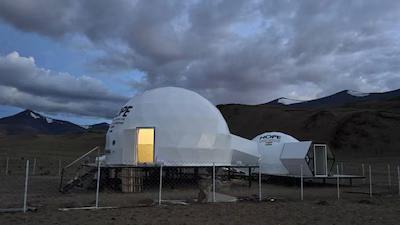
ISRO sets up station in Ladakh to simulate life on Moon & Mars
The Indian Space Research Organisation (ISRO) has set up an ambitious station in Ladakh’s Tso Kar Valley, dubbed the Himalayan Outpost for Planetary Exploration (HOPE), to simulate life on the Moon and Mars. This unique facility will test life-support systems for future lunar and Martian missions, and two crew members will undertake various tests at the facility from August 1-10.
Located at an altitude of 15,000 feet, the Tso Kar Valley was chosen for its extreme environment, which is similar to that of Mars. The valley experiences high UV radiation, low atmospheric pressure, extreme cold, and saline permafrost, making it an ideal location to simulate the harsh conditions of Mars.
The HOPE station is designed to mimic the Martian environment, with temperatures often dropping to -50°C and a lack of oxygen. The crew members will have to survive for 10 days in these conditions, testing the life-support systems, including air, water, and food supplies. The experiment will also simulate the psychological effects of long-duration space travel, as the crew members will be isolated for an extended period.
The HOPE mission is a significant step towards India’s ambitious plans to send humans to the Moon and Mars in the near future. The mission will provide valuable insights into the challenges of long-duration space travel and the psychological effects of isolation. It will also test the feasibility of sustaining life in extreme environments, which is crucial for human exploration of the Moon and Mars.
The HOPE station is equipped with state-of-the-art equipment and facilities, including a habitat module, life-support systems, and communication equipment. The crew members will have to rely on these systems to sustain themselves during their 10-day stay at the station.
The mission is expected to provide valuable data and insights into the challenges of space travel, which will be crucial for future missions. The data collected during the HOPE mission will be used to design and develop life-support systems for future lunar and Martian missions.
The ISRO has been working on its plans to send humans to the Moon and Mars for several years. The organization has already sent several robotic missions to the Moon and Mars, including the Chandrayaan-1 and Mars Orbiter Mission (MOM). The HOPE mission is a significant step towards sending humans to the Moon and Mars, and it will pave the way for future missions.
The HOPE mission is also significant from a scientific perspective. The Tso Kar Valley is one of the most extreme environments on Earth, with temperatures often dropping to -50°C and a lack of oxygen. The valley is also home to several unique species that have adapted to the extreme conditions.
The HOPE mission will provide valuable insights into the biology and ecology of these unique species, which will be crucial for understanding the potential risks and challenges of sending humans to Mars. The mission will also provide valuable data on the effects of long-duration space travel on the human body, which will be crucial for designing and developing life-support systems for future missions.
In conclusion, the HOPE mission is a significant step towards India’s ambitious plans to send humans to the Moon and Mars. The mission will provide valuable insights into the challenges of long-duration space travel and the psychological effects of isolation. It will also test the feasibility of sustaining life in extreme environments, which is crucial for human exploration of the Moon and Mars.
The ISRO’s HOPE mission is a testament to India’s commitment to space exploration and its ambition to become a major player in the global space industry. The mission will pave the way for future missions and will provide valuable data and insights that will be crucial for sending humans to the Moon and Mars.






